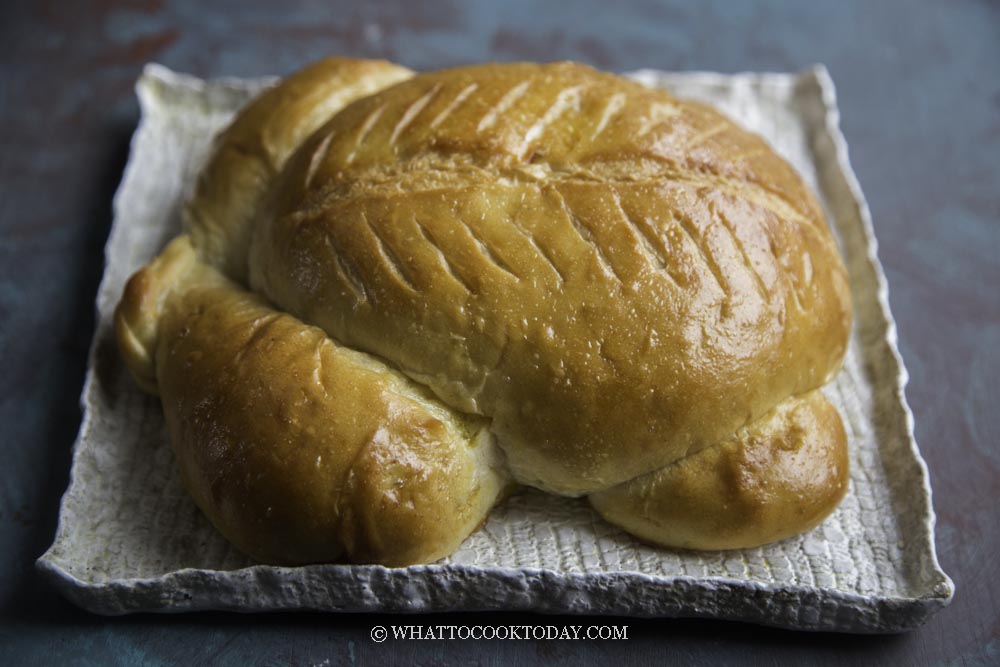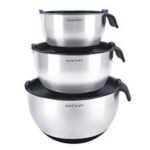This post may contain affiliate links. Please read our disclosure policy.
An easy no-knead sourdough country bread that is shaped like a roasted turkey is a fun and delicious bread to bake for Thanksgiving to share with everyone. This is a tasty sourdough bread that is suitable for bakers of any level, beginner or not!
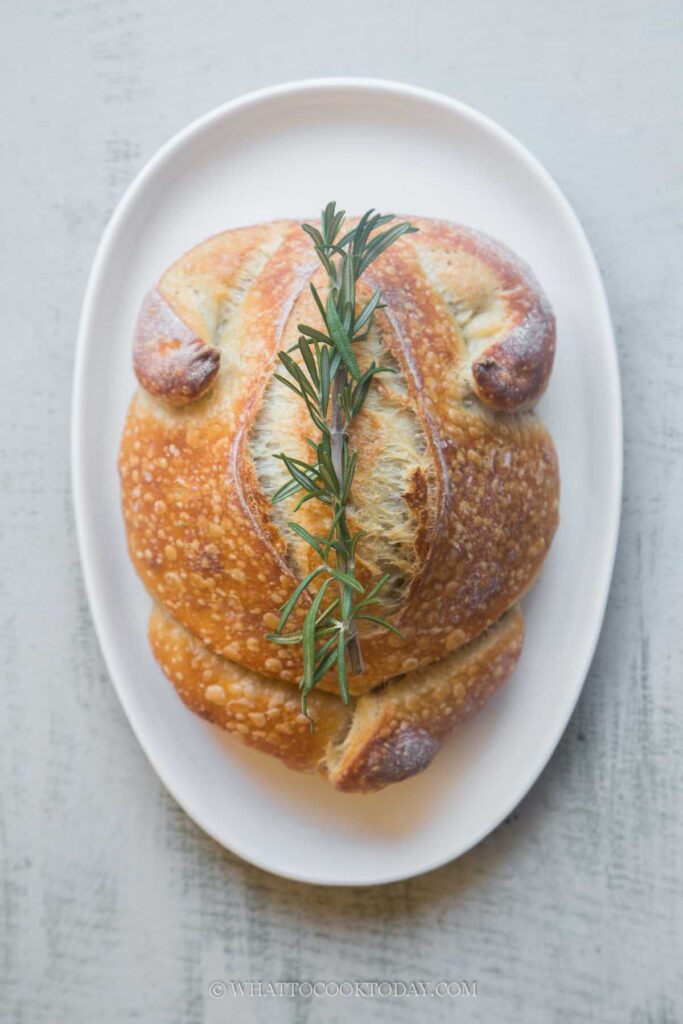
Last year, I made this easy no-knead turkey-shaped soft and fluffy milk bread! This year, I decided to do it on a sourdough loaf! I think we can all agree that the most fun part is shaping the loaf!
Why you’ll love this recipe
1. The dough is easy to work with
Unlike my other sourdough country bread with slightly higher hydration and requires more techniques to achieve open crumbs, this loaf has about 73% hydration and is very easy to work with.
2. No-kneading
The dough requires no kneading at all. You only need 4 sets of stretch and fold and that is it!
3. Tasty with soft crumbs
The crumbs are tighter, but that’s because it’s lower hydration but don’t let that fool you! The crumbs are soft and delicious with a nice crust on the outside
Easy No-Knead Turkey-Shaped Sourdough Bread
Ingredients
- 300 g bread flour (12.7% protein content)
- 60 g active starter (100% hydration) 20%
- 220 g water 73%
- 6 g salt 2%
For dusting banneton:
You will need:
Instructions
- I strongly encourage you to have an active starter that is at least one month old before you attempt to bake this recipe. You can try using your young starter that is at least 2-week old, but the result may not be as satisfactory
- Since I know I will be baking the next day, I will prepare more starter the night before. I will feed at 1:3:3 ratio so it will last me until the next morning, about 10 hours to double or triple at 75-77 F (24-25C). This also depends on the strength of your starter and the room temperature the starter is at. It may be faster or longer.
- I use 10 grams starter + 30 grams flour + 30 grams water. I usually prepare a bit more as some may get stuck to the glass jar, spatula, etc.
- Remember that you want to use your starter at its peak, meaning it has doubled or tripled when you are ready to use it
Fermentolyse:
- Weigh 60 grams of starter into a mixing bowl. Feed the starter as per your normal routine. Combine starter, water, and salt and stir to combine. Add bread flour to a mixing bowl. If you have a dough whisk, you can use that, otherwise, a sturdy spatula or your hand would work too. Stir to combine into a rough wet dough. The whole process probably takes about 3-5 minutes. It is important that there shouldn't be any visible dry bits. All flour needs to be fully hydrated. Cover and let it sit for 1 hour. Maintain dough temperature at 70-72 F (21-22 C) at this stage if possible
- Bulk fermentation begins when you innoculate starter (adding starter) into the dough. In this case, it starts at this fermentolyse step
4 sets of stretch and folds:
- From this point on, I maintain the temperature a bit warmer, at 75-78 F (24-26C). Wet your fingers lightly. Pick up the dough from one of the edges, kinda wiggle it and stretch it up and fold it over. Only stretch as far as the dough allows you too, don't force it.
- Repeat this throughout the edge of the dough. This will be about 4 stretches. Round up the dough and scrape the sides of the bowl to "clean up" a bit. Place the smooth side of the dough up. Cover and rest for 30 minutes
- Do the same stretch and fold again with your slightly wet fingers. You may notice the dough is a bit tighter this round as gluten has developed a bit more. Cover and rest for 30 minutes again. Do this 2 more times, 30 minutes apart. So, it's a total of 4 stretches and folds in a span of 2 hours
Continue with bulk fermentation:
- After the 4th stretch and fold, I usually transfer it to a lightly-oiled bulking container with a lid (or cover with plastic wrap). I marked the side of the container so I know when the dough has doubled or almost doubled in volume. This may take about 3-4 additional hours, depending on your surrounding temperature. It may be faster or slower
Shape into a batard:
- Once the dough has doubled in volume and feels jiggly with air, lightly flour the surface of the dough in the container
- Tip the container upside down to let the dough gently slide down upside down. Dust the surrounding of the dough with flour. Since I use a square container, the dough will be sort of "squarish". If you use a round container, the dough will be "roundish"
- Just use a bench knife to help you stretch the dough out a bit to make it more "squarish". It doesn't have to be a picture-perfect square
- Use a bench knife to tuck in the flour underneath the four edges of the dough
- Gently fold half of the dough over towards you to the center. Repeat with the opposite half, overlapping the first half. Then roll the dough over from one end to the other. You can feel that the dough is jiggly and full of air
- Tuck a bench knife under one side of the dough and push gently to tighten the dough a bit. Seal both ends
Transfer to a banneton:
- I use an 8-inch oval banneton lined with a cloth. 9-inch banneton would work too. Lightly dust the cloth with rice flour on the bottom and the side of the cloth. Lightly dust the top of the shaped dough. Dust off some excess. Very gently, using the help of the bench scraper to flip the dough onto your palm. So the seam side is facing you now. Gently put the dough into the prepared banneton. The seam side is up. I like to tighten and seal the seam by pulling a bit of the dough from both sides
Cold retard the dough:
- Place the dough inside a produce plastic bag and twist the bag and secure with a clip. Any large ziploc bag would work too. Put this inside the coldest part of your fridge. Make sure the fridge is cold enough at 37-38 F (3-4 C). This is important so the dough won't continue to ferment and you end up with an over-proofed dough. Let the dough cold retard for 12-24 hours
Preheating the oven:
- I bake using a cast-iron dutch oven. 45 minutes before you plan to bake, position one oven rack at the lowest level and then another one rack above it. Place the dutch oven and its lid at the 2nd rack. I keep the pot and the lid separated during preheating. Preheat the oven together with the dutch oven to 485 F (250 C) for 45 minutes to 1 hour
- Cut a parchment paper about 2 inches bigger than the size of your banneton. I have a combo cooker Dutch oven, which is nice because I can load the dough with less risk of getting burnt on my arms. If you have a regular Dutch oven pot, you want to cut parchment paper so that it has a "handle" so you can lift the handle and lower the dough into the pot without getting burnt.
Shape into a turkey shape:
- When the oven has preheated for 45 minutes, get the dough out of the refrigerator. There is no need to let it come to room temperature. We want it cold so it's easier to cut and shape.
- Place the parchment paper covering the top of the banneton and turn it over so the dough is now sitting on top of the parchment paper
- Use a bench knife to make two upper diagonal cuts for the wings, taking care not to cut off the dough completely. Refer to photos below if you need to
- Bring the wings over to the center and secure with a toothpick so they stay in place during baking
- Next make another two lower diagonal cuts for the drumsticks. This time, you want to cut the dough off completely. Then I make the top part of the drumsticks slightly more roundish. Place them slightly lower than the position where you cut them. I overlap the bottom of the drumstick slightly (just so it looks more "real", there's no right or wrong here!). Make a score, about 1/2-inch deep on the center of the dough
- Wear a mitten and carefully get the Dutch oven pot and its lid out from the oven and place one baking sheet on the lowest rack and quickly but carefully close the oven's door back to prevent too much heat loss. This helps to prevent the bottom crust of your bread from being too thick and tough
Baking:
- Carefully load the dough by lifting the parchment paper and lower it into the pot or the combo cooker. Spray generously with water to create those nice crackles (and it makes the bread look like roasted turkey too). Close the lid. Open the oven door again and carefully transfer the pot into the oven again and close the oven door. Lower the temperature to 450 F (230 C) and bake for 30 minutes
- After 30 minutes remove the Dutch oven from the oven. Transfer the half-baked bread to a regular baking sheet and put this back inside the oven. Again, this is to help create a nice thin crust all around
- Lower the oven temperature to 425 F (220 C) and bake for 15 minutes. Rotate the bread halfway during this second portion of baking
- After 15 minutes, turn off the oven and open the oven door slightly to let the hot air out and let the bread sit in the oven for 15 minutes. This helps to "cure" the bread without overcooking it, so the inside won't be wet and gummy
Cooling down:
- After that, get the bread out of the oven and transfer it to a cooling rack immediately and now comes the hardest part! You need to wait for at least 3-4 hours or longer before you slice it. If you slice into warm bread, you will end up with gummy crumbs
Store:
- Once the bread has cooled down completely, you can store it in a bread box if you plan to consume it in the next few days. You can also put it inside a paper bag
- For longer storage, you can wrap the whole loaf or sliced bread in plastic wrap and then put inside a freezer bag. Push all the air out and seal. It can be kept frozen for 1-2 months. Simply thaw at room temperature before serving and then reheat them in toaster or air-fryer. Most toasters these days can toast frozen sliced bread. So you may not even need to thaw it completely
RECOMMEDED TOOLS
*Nutrition facts are just estimates and calculated using online tools*

How to prepare easy no-knead sourdough country bread
1. Weigh 60 grams of starter into a mixing bowl. Feed the starter as per your normal routine. Combine starter, water, and salt and stir to combine. Add bread flour to a mixing bowl. If you have a dough whisk, you can use that, otherwise, a sturdy spatula or your hand would work too. Stir to combine into a rough wet dough. The whole process probably takes about 3-5 minutes. It is important that there shouldn’t be any visible dry bits. All flour needs to be fully hydrated. Cover and let it sit for 1 hour. Maintain dough temperature at 70-72 F (21-22 C) at this stage if possible. Bulk fermentation begins when you innoculate starter (adding starter) into the dough. In this case, it starts at this fermentolyse step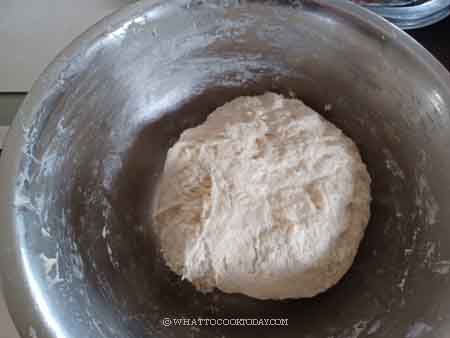
2. 4 sets of stretch and folds: From this point on, I maintain the temperature a bit warmer, at 75-78 F (24-26C). Wet your fingers lightly. Pick up the dough from one of the edges, kinda wiggle it and stretch it up and fold it over. Only stretch as far as the dough allows you too, don’t force it.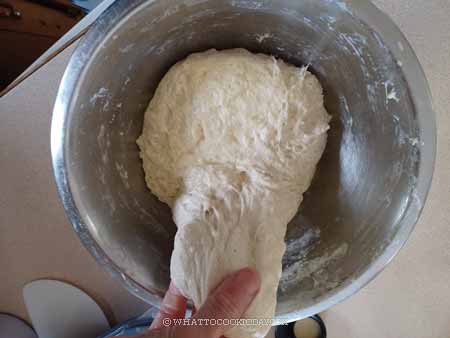
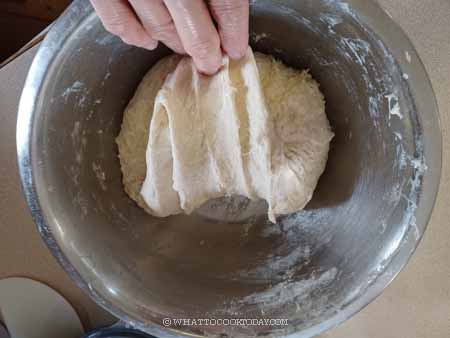
3. Repeat this throughout the edge of the dough. This will be about 4 stretches. 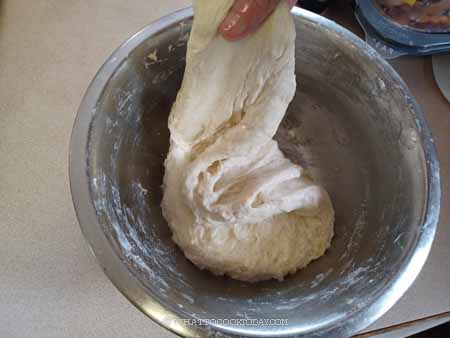
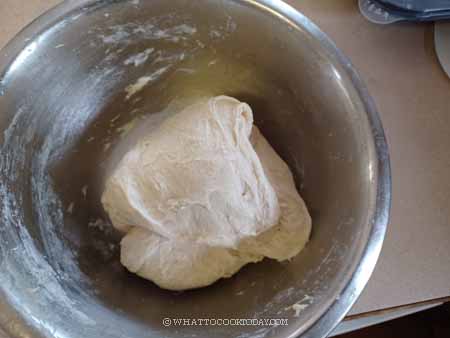
4. Round up the dough and scrape the sides of the bowl to “clean up” a bit. Place the smooth side of the dough up. Cover and rest for 30 minutes. Do the same stretch and fold again with your slightly wet fingers. You may notice the dough is a bit tighter this round as gluten has developed a bit more. Cover and rest for 30 minutes again. Do this 2 more times, 30 minutes apart. So, it’s a total of 4 stretches and folds in a span of 2 hours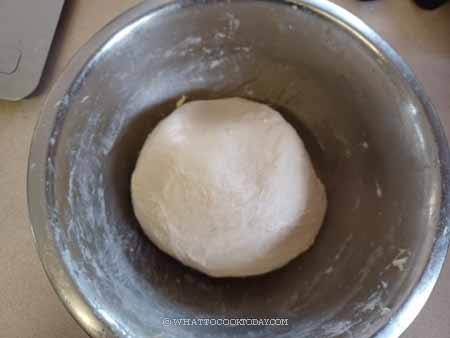
5. After the 4th stretch and fold, I usually transfer it to a lightly-oiled bulking container with a lid (or cover with plastic wrap). I marked the side of the container so I know when the dough has doubled or almost doubled in volume. This may take about 3-4 additional hours, depending on your surrounding temperature. It may be faster or slower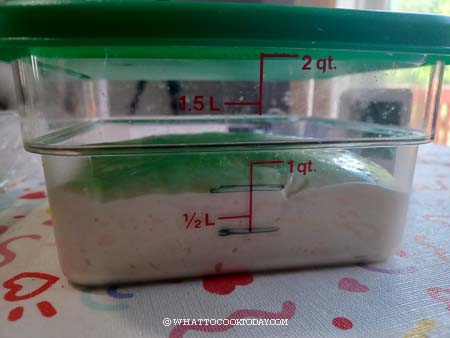
6. Once the dough has doubled in volume and feels jiggly with air, lightly flour the surface of the dough in the container. Tip the container upside down to let the dough gently slide down upside down. Dust the surrounding of the dough with flour. Since I use a square container, the dough will be sort of “squarish”. If you use a round container, the dough will be “roundish”. Use a bench knife to tuck in the flour underneath the four edges of the dough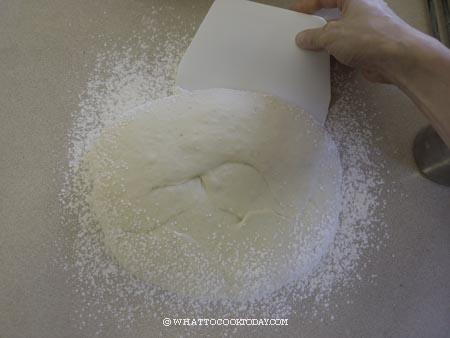
7. Gently fold half of the dough over towards you to the center. Repeat with the opposite half, overlapping the first half. Then roll the dough over from one end to the other. You can feel that the dough is jiggly and full of air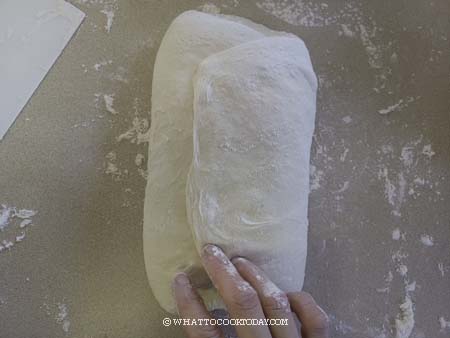
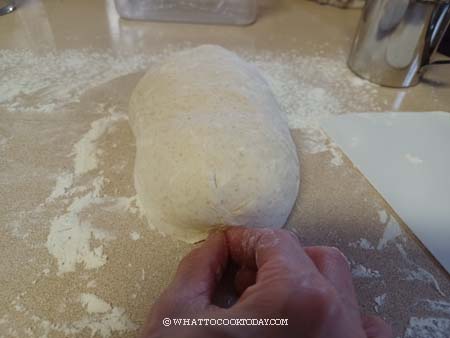
8. I use an 8-inch oval banneton lined with a cloth. 9-inch banneton would work too. Lightly dust the cloth with rice flour on the bottom and the side of the cloth. Lightly dust the top of the shaped dough. Dust off some excess. Very gently, using the help of the bench scraper to flip the dough onto your palm. So the seam side is facing you now. Gently put the dough into the prepared banneton. The seam side is up. I like to tighten and seal the seam by pulling a bit of the dough from both sides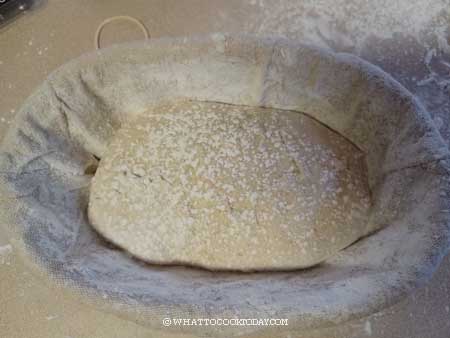
9. Place the dough inside a produce plastic bag and twist the bag and secure with a clip. Any large ziploc bag would work too. Put this inside the coldest part of your fridge. Make sure the fridge is cold enough at 37-38 F (3-4 C). This is important so the dough won’t continue to ferment and you end up with an over-proofed dough. Let the dough cold retard for 12-24 hours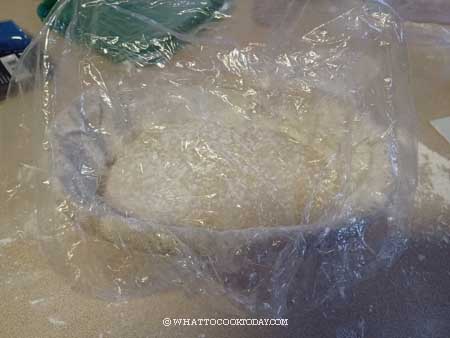
How to shape sourdough bread into a turkey shape
1. Get the dough out of the refrigerator. There is no need to let it come to room temperature. We want it cold so it’s easier to cut and shape. Place the parchment paper covering the top of the banneton and turn it over so the dough is now sitting on top of the parchment paper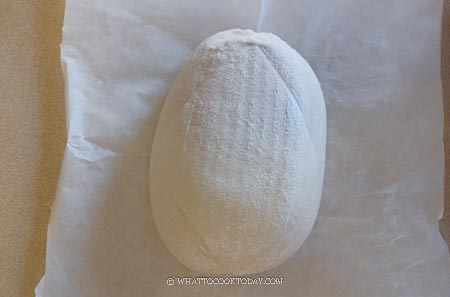
2. Use a bench knife to make two upper diagonal cuts for the wings, taking care not to cut off the dough completely. 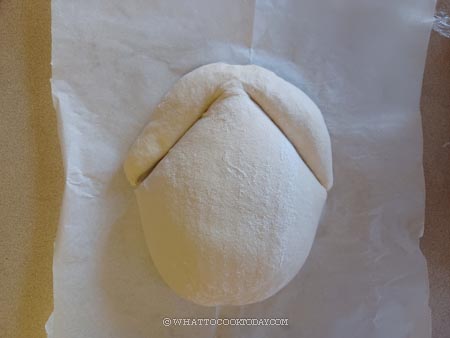
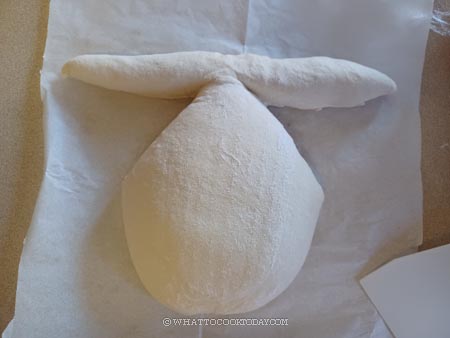
3. Bring the wings over to the center and secure with a toothpick so they stay in place during baking. Next make another two lower diagonal cuts for the drumsticks. This time, you want to cut the dough off completely. 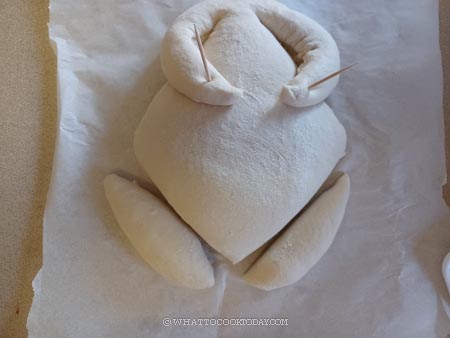
4. Then I make the top part of the drumsticks slightly more roundish. Place them slightly lower than the position where you cut them. I overlap the bottom of the drumstick slightly (just so it looks more “real”, there’s no right or wrong here!). 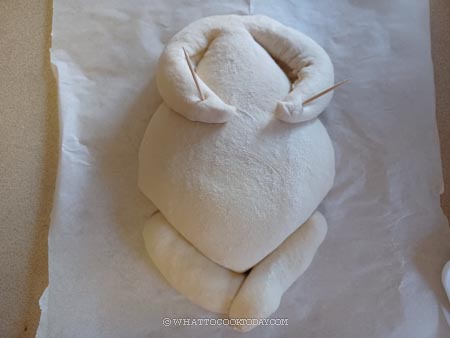
5. Make a slight indentation on top of the dough (where the “neck” is supposed to be at)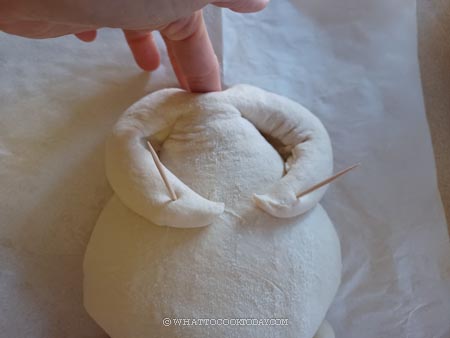
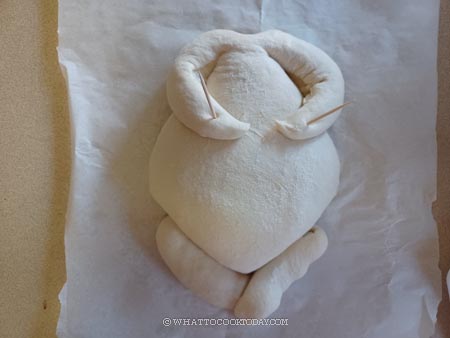
5. Make a score, about 1/2-inch deep on the center of the dough and it needs to go into the oven immediately after that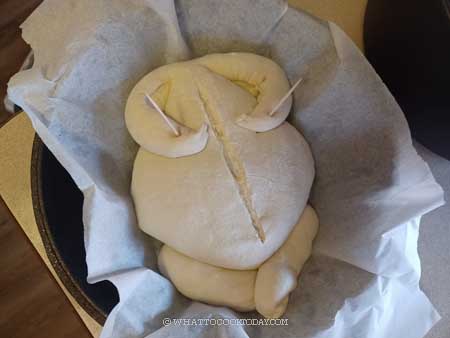
How to bake turkey-shape sourdough country bread
1. 45 minutes, before you start shaping the bread into a turkey shape, as shown above, position one oven rack at the lowest level and then another one rack above it. Place the dutch oven and its lid at the 2nd rack. I keep the pot and the lid separated during preheating. Preheat the oven together with the dutch oven to 485 F (250 C) for 45 minutes to 1 hour
2. Carefully load the dough by lifting the parchment paper and lower it into the pot or the combo cooker. Spray generously with water to create those nice crackles (and it makes the bread look like roasted turkey too). Close the lid. Open the oven door again and carefully transfer the pot into the oven again and close the oven door. Lower the temperature to 450 F (230 C) and bake for 30 minutes
3. After 30 minutes remove the Dutch oven from the oven. 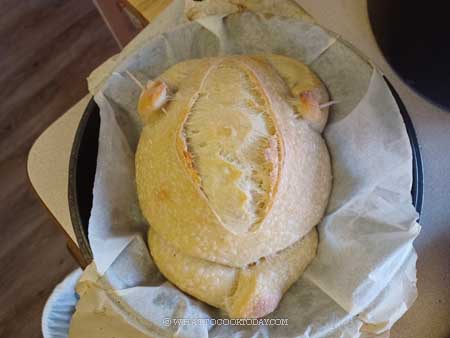
4. Transfer the half-baked bread to a regular baking sheet and put this back inside the oven. Again, this is to help create a nice thin crust all around. Lower the oven temperature to 425 F (220 C) and bake for 15 minutes. Rotate the bread halfway during this second portion of baking. After 15 minutes, turn off the oven and open the oven door slightly to let the hot air out and let the bread sit in the oven for 15 minutes. This helps to “cure” the bread without overcooking it, so the inside won’t be wet and gummy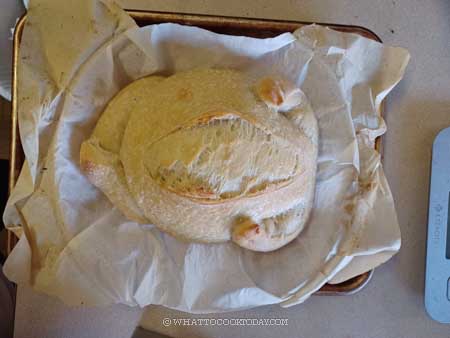
5. After that, get the bread out of the oven and transfer it to a cooling rack immediately and now comes the hardest part! You need to wait for at least 3-4 hours or longer before you slice it. If you slice into warm bread, you will end up with gummy crumbs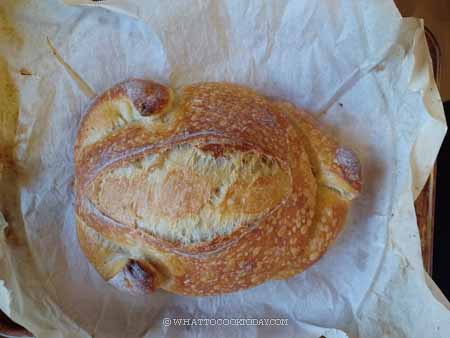
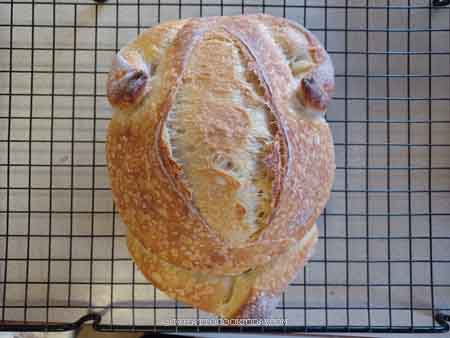
Did you make this easy no-knead turkey-shaped sourdough bread recipe?
I love it when you guys snap a photo and tag it to show me what you’ve made. Simply tag me @WhatToCookToday #WhatToCookToday on Instagram and I’ll be sure to stop by and take a peek for real!

You may also like this turkey-shaped milk bread
